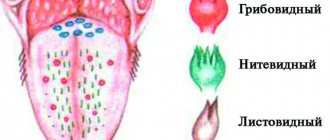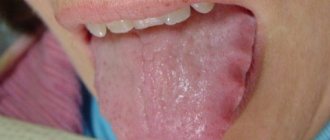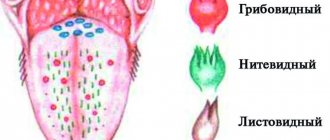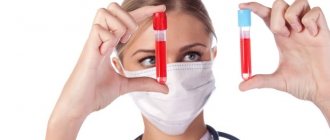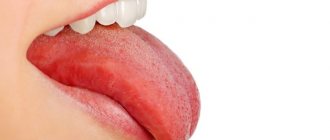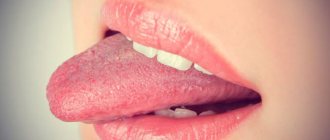Causes
Factors that provoke the development of inflammatory processes include:
- Diarrhea and food poisoning - harmful substances released during bowel movements negatively affect the papillae;
- An inactive lifestyle - this contributes to the appearance of stagnant processes in the pelvis;
- Constipation, in which the papillae are injured during bowel movements;
- Abuse of enemas - with frequent procedures, the mucous membrane of the anal canal is damaged;
- Drinking alcoholic beverages;
- Allergy to personal hygiene products, underwear material;
- Proctological diseases: critpitis, proctitis.
Diagnostics
If papillitis is suspected, the proctologist performs:
- Visual inspection;
- Palpation;
- Anamnesis collection.
If the nodules are located inside the anus, the patient will have to strain to get them out.
To obtain information about the condition of the rectum, the patient is referred to:
- Anoscopy - an anoscope is used for examination, which allows you to examine a section of the rectum 10-12 cm long from the anus and diagnose various proctological pathologies: polyps, bleeding, etc.
- Sigmoidoscopy - allows you not only to examine the rectum at a distance of up to 25 cm, but also to take samples for histology and to excise detected tumors.
Mandatory diagnostic measures include laboratory tests: stool, blood and smear analysis, flora culture, etc.
The need for differential diagnosis is due to the fact that the symptoms of papillitis are similar to some other proctological diseases. Therefore, in order to accurately establish a diagnosis, it is important to exclude the development of other pathologies. Hypertrophied papillae develop a stalk, so they resemble a polyp in many ways. Sometimes you need to make sure that these are not sentinel tubercles formed by fissures in the anus.
What can changes in the state of the language indicate?
- White, grayish-white or yellow coating. Normally, a small coating is observed in most people, mainly in the morning, but it is so thin that the papillae of the tongue are clearly visible through it. A dense, persistent plaque almost always indicates a chronic pathology of the digestive tract. In case of diseases of the stomach, the middle of the tongue is covered, in case of intestinal pathologies - its root. During exacerbations, plaque becomes more pronounced, and during periods of remission it can completely disappear. Initially, the plaque has a grayish color, then, under the influence of food dyes or due to medication, it gradually turns yellow.
- Brown or black coating. Indicates problems with the liver or gall bladder (stones, cholecystitis, dyskinesia).
- Swelling of the tongue. It is a characteristic sign of inflammatory bowel diseases (colitis, enterocolitis). The swelling itself does not cause any inconvenience to the patient and is determined only by the imprints of the teeth on the tip and lateral surfaces of the tongue.
- Changes in the papillae of the tongue. Hypertrophy (enlargement) of the papillae that protrude above the surface of the tongue may indicate the development of a gastric or duodenal ulcer. A smooth “varnished” tongue indicates gastritis with low acidity, inflammation of the gallbladder or biliary dyskinesia.
Treatment
If the papillae are in normal condition and do not bother a person, then they do not require medical intervention. Therapy is needed in case of development of inflammatory processes. The following can be used to treat papillitis:
- Conservative techniques;
- Operational methods.
But initially the cause of the disease must be eliminated. Without this, only temporary results can be achieved. If you undergo a course of medication or surgical treatment, but do not eliminate the root cause of the formation of the papillae, then after some time they will become inflamed again.
Conservative treatment
In this case, the doctor prescribes medications with anti-inflammatory, analgesic, antimicrobial and immunomodulatory effects. If the patient suffers from constipation, then the treatment regimen includes laxatives, and for diarrhea, medications to normalize stool. Colloidal solutions may also be prescribed to facilitate bowel movements.
Nutrition is of no small importance. The diet for papillitis should include light foods aimed at improving intestinal activity. Therefore, it is recommended to consume more vegetables, fruits, and dairy products. Sweets, fried, spicy and salty foods should be excluded from the diet. The consumption of alcoholic beverages is strictly prohibited. The patient must also stop smoking.
Operational methods
Surgical treatment consists of excision of the tumor. For this purpose the following is used:
- Radio wave technique - removal of papillae using the Surgitron device, the action of which is based on the generation of high-frequency radio waves into thermal energy. Heat, acting on cells, stimulates their evaporation;
- Ligation with latex rings - the essence of the technique is to throw a ring onto the pedicle of the hypertrophied papilla in order to compress the vessels that feed the neoplasm cells. After this, the papilla shrinks and as a result it disappears.
Anal papillae
Causes of inflammation of the anal papillae
Papillitis occurs due to the following factors and diseases:
- frequent constipation or diarrhea;
- presence of anal fissures;
- hemorrhoids with prolapse of hemorrhoids;
- proctitis (inflammation of the rectal mucosa);
- cryptitis (inflammation of the Morganian crypt);
- internal fistulas in the rectal area;
- food poisoning;
- allergic reactions (to hygiene items, underwear fabric, enemas components, etc.)
- physical inactivity (sedentary lifestyle);
- alcohol consumption.
Exposure to these factors on a frequent basis can lead to hypertrophy of the anal papillae and, accordingly, to their inflammation. If there are signs of papillitis, you should contact a proctologist.
Symptoms of papillitis
Various symptoms and discomfort in the anal area indicate the presence of a disease. However, we do not recommend self-diagnosis and self-medication - only an experienced and qualified proctologist can establish an accurate diagnosis.
When the anal papillae become inflamed, the following symptoms are observed:
When the anal papillae become inflamed, the following symptoms are observed:
- pain in the perianal area;
- feeling of a foreign body in the anal canal;
- itching and maceration;
- rectal discharge;
- blood in the stool;
- burning sensation;
- redness of the skin;
- the appearance of ulcers at the apex of the papillae.
If you notice any symptoms, you should immediately contact a specialist.
Diagnosis and treatment
A proctologist diagnoses and treats inflamed anal papillae. At the doctor’s appointment, the patient is asked for complaints, anamnesis is collected and a series of instrumental or laboratory tests are prescribed.
Hypertrophied anal papillae are usually noticeable during initial visual examination and can be easily felt by palpation. To obtain a more complete picture of the condition of the large intestine, studies such as sigmoidoscopy and colonoscopy are performed. It is necessary to differentiate between papillitis and intestinal polyposis. Intestinal polyps are usually located above the anorectal area and have a red tint. The anal papillae are located at the level of the anorectal line; they are covered with stratified epithelium, which gives the papillae a pale color, like the lining of the anal canal.
Enlarged anal papillae cause pain and discomfort and require immediate treatment. Conservative treatment consists of using local medications, ointments and suppositories to relieve inflammation. If prolapse of the anal papillae is observed, they are most often removed surgically. Today, there are several reliable and safe methods for removing anal papillae. These include:
- laser therapy;
- radio wave method;
- cauterization with liquid nitrogen.
The Naedine Clinic performs effective operations in the field of aesthetic proctology, in particular, operations to remove anal papillae. Make an appointment with any of the five proctologists at our clinic by calling 8332 32-77-77 or using the feedback form on the website.
Prevention of papillitis
To avoid inflammation of the anal papillae, it is recommended:
- Observe hygiene procedures: rinse the anus after each act of bowel movement;
- If gastrointestinal diseases are detected, undergo timely treatment;
- Move more to eliminate congestion in the pelvic area;
- Get rid of bad habits (smoking, drinking alcohol);
- Avoid “heavy” foods;
- In case of constipation, use laxatives.
We care about your health
Anal papillae (papillitis)
Anal papillae are called new tissue formations that are located on the dentate line - the border of the anal canal and the lower part of the rectum. In children, this is a variant of the norm, but as they grow older, they should either resolve completely or decrease to a size of no more than 1 cm - then such neoplasms will not cause any inconvenience. But sometimes the papillae begin to become inflamed, increase in size, and sometimes “fall out” into the anus. This is how papillitis occurs - an inflammatory disease of hypertrophied anal papillae.
Causes of the disease and its symptoms
Here's what can trigger papillitis::
- sedentary and sedentary lifestyle, causing congestion in the pelvic area;
- abuse of enemas;
- physical and chemical trauma to the anus;
- frequent diarrhea and constipation;
- unhealthy diet: a lot of fatty and fried foods, sweets, alcoholic drinks;
- diseases of the anal canal: hemorrhoids, cryptitis, sphincteritis, fissures.
Papillitis is difficult to see on your own, but there are other obvious symptoms. It is worth making an appointment with a proctologist if mucous, purulent or bloody discharge appears and you feel:
- itching and pain in the anus;
- feeling of incomplete bowel movement after bowel movement;
- sensation of a foreign body in the anus.
Any of these symptoms cannot be ignored: they can indicate not only papillitis, but also a more serious disease - polyposis, which is fraught with malignant intestinal tumors.
Diagnostics
To make a diagnosis, the proctologist conducts a digital examination of the rectum: this way you can manually feel the hypertrophied anal papillae. But this is not enough to prescribe therapy: you need to know the exact number of papillae and the degree of their inflammation. For this, the patient is prescribed instrumental examinations - anoscopy or sigmoidoscopy, sometimes radiography is also required.
How is anoscopy performed? It uses an anoscope, an instrument similar to a speculum. It is inserted into the anus to see the rectum to a depth of 12 cm. Today this method is considered outdated and is rarely prescribed.
A more accurate and modern diagnostic method is sigmoidoscopy. The proctologist examines the intestine (to a depth of 35 cm) using a device that looks like a metal tube. It contains a lighting device, an air injection device and an eyepiece. One of the advantages of sigmoidoscopy is that the doctor will be able to take a sample of the tumor for cytology.
Before anoscopy and sigmoidoscopy, the patient is prescribed a cleansing enema. Both examinations are painless and discomfort is minimized. For patients with hypersensitivity, the doctor offers local anesthesia.
Treatment
Papillitis needs to be treated only if the anal papillae interfere with normal life: they often become inflamed, bleed, fall out of the rectum, and interfere with bowel movements. You can get rid of this unpleasant disease conservatively or surgically.
In the first case, the patient is prescribed antibacterial and anti-inflammatory therapy. If treatment does not produce results, the proctologist may insist on removing the formations. This is not an abdominal operation, and you should not be afraid of it, since it is performed under local anesthesia and the risk of complications is minimal. Most often, the patient is discharged from the hospital within 24 hours. You can also remove the nipple with electric current (diathermocoagulation) or freeze it with liquid nitrogen (cryodestruction).
Prevention
To avoid inflammation of the anal papillae, it is important to follow simple rules of a healthy lifestyle:
Move more, especially for people whose work involves working on a computer. The gym, evening or morning jogging, walks in the park, visiting the pool - all this will help avoid congestion in the pelvic area.
Eat healthy foods rich in fiber. This is necessary for normal digestion, and therefore the prevention of constipation and diarrhea. The healthiest foods are fruits, vegetables, berries, herbs, legumes and nuts. Pasta and pasta can only be eaten from durum wheat, and baked goods - from wholemeal flour. Animal fats should be replaced with unrefined vegetable oils. Meat should be lean, and fermented milk products should have an average fat content. The diet should include bran and dried fruits, but you will have to give up canned, pickled, fried, smoked, spicy and salty foods. You should eat small meals five times a day.
Maintain drinking regime. Lack of fluid in the body impairs metabolism and can lead to constipation. Give up alcohol and cigarettes: they are also bad
Take care of careful hygiene of the anus. It is better to stop using toilet paper and wash yourself with clean running water after each bowel movement: this will reduce the risk of injury to the rectum and infection.
Prevention of papillitis is especially necessary for people who have already experienced inflammation of the anal papillae: unfortunately, this disease can return.

